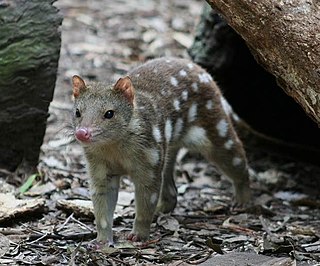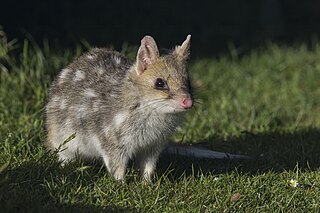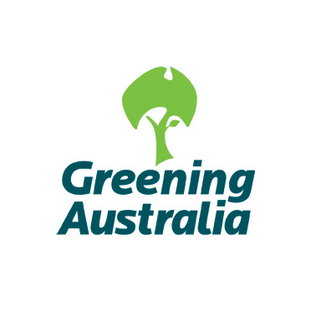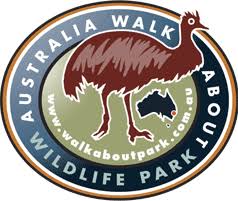
The Tasmanian devil is a carnivorous marsupial of the family Dasyuridae. It was formerly present across mainland Australia, but became extinct there around 3,500 years ago; it is now confined to the island of Tasmania. The size of a small dog, the Tasmanian devil became the largest carnivorous marsupial in the world following the extinction of the thylacine in 1936. It is related to quolls, and distantly related to the thylacine. It is characterised by its stocky and muscular build, black fur, pungent odour, extremely loud and disturbing screech, keen sense of smell, and ferocity when feeding. The Tasmanian devil's large head and neck allow it to generate among the strongest bites per unit body mass of any extant predatory land mammal. It hunts prey and scavenges on carrion.

The Barrington Tops National Park is a protected national park in the Hunter Valley in New South Wales, Australia. Gazetted in 1969, the 76,512-hectare (189,070-acre) park is situated between Scone, Singleton, Dungog, Gloucester and East Gresford.

Freycinet National Park is a national park on the east coast of Tasmania, Australia, 125 kilometres (78 mi) northeast of Hobart. It occupies a large part of the Freycinet Peninsula, named after French navigator Louis de Freycinet, and Schouten Island. Founded in 1916, it is Tasmania's oldest park, along with Mount Field National Park. Bordering the national park is the small settlement of Coles Bay, and the largest nearby town is Swansea. Freycinet contains part of the rugged Tasmanian coastline and includes the secluded Wineglass Bay. Features of the park include its red and pink granite formations and a series of jagged granite peaks in a line, called "The Hazards".

Pademelons are small marsupials in the genus Thylogale, found in Australia and Aru, Kai plus New Guinea islands. They are some of the smallest members of the macropod family, which includes the similar-looking but larger kangaroos and wallabies. Pademelons are distinguished by their small size and their short, thick, and sparsely-haired tails. Like most other marsupials, they carry their young in a pouch.

The tiger quoll, also known as the spotted-tailed quoll, spotted quoll, spotted-tailed dasyure, or tiger cat, is a carnivorous marsupial of the quoll genus Dasyurus native to Australia. With males and females weighing around 3.5 and 1.8 kg, respectively, it is the world's second-largest extant carnivorous marsupial, behind the Tasmanian devil. Two subspecies are recognised; the nominate is found in wet forests of southeastern Australia and Tasmania, and a northern subspecies, D. m. gracilis, is found in a small area of northern Queensland and is endangered.

Quolls are carnivorous marsupials native to Australia and New Guinea. They are primarily nocturnal and spend most of the day in a den. Of the six species of quoll, four are found in Australia and two in New Guinea. Another two species are known from fossil remains in Pliocene and Pleistocene deposits in Queensland. Genetic evidence indicates that quolls evolved around 15 million years ago in the Miocene, and that the ancestors of the six species had all diverged by around four million years ago. The six species vary in weight and size, from 300 g (11 oz) to 7 kg (15 lb). They have brown or black fur and pink noses. They are largely solitary, but come together for a few social interactions such as mating which occurs during the winter season. A female gives birth to up to 30 pups, but the number that can be raised to adulthood is limited by the number of teats (6–7). They have a life span of 1–5 years.

Greening Australia is an Australian environmental organisation, founded in 1982, the International Year of the Tree, to protect, restore and conserve Australia's native vegetation. Greening Australia was formed by the United Nations Association of Australia and the Nursery Industry Association of Australia.

Devil facial tumour disease (DFTD) is an aggressive non-viral clonally transmissible cancer which affects Tasmanian devils, a marsupial native to the Australian island of Tasmania. The cancer manifests itself as lumps of soft and ulcerating tissue around the mouth, which may invade surrounding organs and metastasise to other parts of the body. Severe genetic abnormalities exist in cancer cells—for example, DFT2 cells are tetraploid, containing twice as much genetic material as normal cells. DFTD is most often spread by bites, when teeth come into contact with cancer cells; less important pathways of transmission are ingesting of infected carcasses and sharing of food. Adult Tasmanian devils who are otherwise the fittest are most susceptible to the disease.

The eastern quoll is a medium-sized carnivorous marsupial (dasyurid), and one of six extant species of quolls. Endemic to Australia, they occur on the island state of Tasmania, but were considered extinct on the mainland after 1963. The species has been reintroduced to fox-proof fenced sanctuaries in Victoria in 2003 and to the Australian Capital Territory in 2016.

The yellow-footed rock-wallaby, formerly known as the ring-tailed rock-wallaby, is a member of the macropod family.

The western quoll is Western Australia's largest endemic mammalian carnivore. One of the many marsupial mammals native to Australia, it is also known as the chuditch. The species is currently classed as near-threatened.

The Western barred bandicoot, also known as the Shark Bay bandicoot or the Marl, is a small species of bandicoot; now extinct across most of its former range, the western barred bandicoot only survives on offshore islands and in fenced sanctuaries on the mainland.
Mount Rothwell Biodiversity Interpretation Centre is the largest feral-predator-free ecosystem in Victoria, Australia. It is located just north of the You Yangs, near the town of Little River.
Dr John Wamsley is an Australian environmentalist. He was the Prime Minister's Environmentalist of the Year for 2003. Wamsley is known for his attempt to set up a network of wildlife sanctuaries across Australia.

Moonlit Sanctuary Wildlife Conservation Park is a 25-acre (10 ha) biopark within the Pearcedale Conservation Park located at Pearcedale on the Mornington Peninsula near Melbourne, Australia. It aims to display the fauna that was found in the Mornington Peninsula and Western Port Biosphere Reserve prior to European settlement as well as working towards the recovery of threatened Australian fauna. The park is open all year except on Christmas Day. The sanctuary, as part of Pearcedale Conservation Park, is an institutional member of the Zoo and Aquarium Association (ZAA). It is ECO Certified at the Ecotourism level by Ecotourism Australia.

The Australian Wildlife Conservancy (AWC) is an independent Australian nonprofit organisation, working to conserve threatened wildlife and ecosystems in Australia. AWC is the largest private owner and manager of land for conservation in Australia, currently managing 31 sanctuaries and partnership sites for wildlife conservation that cover over 6.5 million hectares of land across Australia. It partners with governmental agencies, Indigenous groups, and private landholders to manage landscapes for effective conservation. Most funding comes from private support in the form of tax-deductible donations from the public, as well as some government grants for particular purposes, such as from the Australian government's National Reserve System Program.

Tasmania Zoo is a zoo located in Launceston, in the Australian state of Tasmania. Situated on 900 acres (360 ha) of old growth native bushland, it is home to the state's largest collection of native and exotic animals. Tasmania Zoo is a fully accredited member of the Zoo and Aquarium Association, working closely with all Australasian zoos, and are involved in various species management programs.

Mulligans Flat Woodland Sanctuary is a protected area situated in the Gungahlin district in north Canberra in the Australian Capital Territory. It has several trails for walking, running and cycling. The sanctuary functions as a fieldwork site for researchers studying native ecology.
Aussie Ark, formerly Devil Ark, is an animal preservation project based near the Barrington Tops of New South Wales, Australia. The wildlife sanctuary is called the Barrington Wildlife Sanctuary.

Australia Walkabout Wildlife Park is a wildlife sanctuary located in Calga, New South Wales, Australia. The wildlife park is home to Australian native birds, mammals and reptiles as well as farm animals. It offers research and education programs, with visitors able to undertake day and night tours. The park is home to a wide range of Australian animals and in 2021 became home to a group of meerkats, the park's first exotic animals.
















